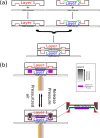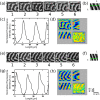Mapping out Min protein patterns in fully confined fluidic chambers
- PMID: 27885986
- PMCID: PMC5217063
- DOI: 10.7554/eLife.19271
Mapping out Min protein patterns in fully confined fluidic chambers
Abstract
The bacterial Min protein system provides a major model system for studying reaction-diffusion processes in biology. Here we present the first in vitro study of the Min system in fully confined three-dimensional chambers that are lithography-defined, lipid-bilayer coated and isolated through pressure valves. We identify three typical dynamical behaviors that occur dependent on the geometrical chamber parameters: pole-to-pole oscillations, spiral rotations, and traveling waves. We establish the geometrical selection rules and show that, surprisingly, Min-protein spiral rotations govern the larger part of the geometrical phase diagram. Confinement as well as an elevated temperature reduce the characteristic wavelength of the Min patterns, although even for confined chambers with a bacterial-level viscosity, the patterns retain a ~5 times larger wavelength than in vivo. Our results provide an essential experimental base for modeling of intracellular Min gradients in bacterial cell division as well as, more generally, for understanding pattern formation in reaction-diffusion systems.
Keywords: E. coli; Microfluidics; Min system; biophysics; in vitro reconstitution; pattern formation; reaction-diffusion; structural biology.
Conflict of interest statement
The authors declare that no competing interests exist.
Figures















Similar articles
-
Min-protein oscillations in Escherichia coli with spontaneous formation of two-stranded filaments in a three-dimensional stochastic reaction-diffusion model.Phys Rev E Stat Nonlin Soft Matter Phys. 2006 Feb;73(2 Pt 1):021904. doi: 10.1103/PhysRevE.73.021904. Epub 2006 Feb 13. Phys Rev E Stat Nonlin Soft Matter Phys. 2006. PMID: 16605359
-
Surface waves of Min-proteins.Phys Biol. 2007 Mar 22;4(1):38-47. doi: 10.1088/1478-3975/4/1/005. Phys Biol. 2007. PMID: 17406084
-
Mesoscale modeling technique for studying the dynamics oscillation of Min protein: pattern formation analysis with lattice Boltzmann method.Comput Biol Med. 2009 May;39(5):412-24. doi: 10.1016/j.compbiomed.2009.02.003. Epub 2009 Apr 1. Comput Biol Med. 2009. PMID: 19342013
-
An experimentalist's guide to computational modelling of the Min system.Mol Microbiol. 2007 Mar;63(5):1279-84. doi: 10.1111/j.1365-2958.2007.05607.x. Mol Microbiol. 2007. PMID: 17302810 Free PMC article. Review.
-
Recognition mechanisms of DNA-specific enzymes.Annu Rev Biochem. 1976;45:889-920. doi: 10.1146/annurev.bi.45.070176.004325. Annu Rev Biochem. 1976. PMID: 134668 Review. No abstract available.
Cited by
-
Directing Min protein patterns with advective bulk flow.Nat Commun. 2023 Jan 27;14(1):450. doi: 10.1038/s41467-023-35997-0. Nat Commun. 2023. PMID: 36707506 Free PMC article.
-
C-terminal eYFP fusion impairs Escherichia coli MinE function.Open Biol. 2020 May;10(5):200010. doi: 10.1098/rsob.200010. Epub 2020 May 27. Open Biol. 2020. PMID: 32456552 Free PMC article.
-
De novo synthesized Min proteins drive oscillatory liposome deformation and regulate FtsA-FtsZ cytoskeletal patterns.Nat Commun. 2019 Oct 31;10(1):4969. doi: 10.1038/s41467-019-12932-w. Nat Commun. 2019. PMID: 31672986 Free PMC article.
-
Effects of geometry and topography on Min-protein dynamics.PLoS One. 2018 Aug 30;13(8):e0203050. doi: 10.1371/journal.pone.0203050. eCollection 2018. PLoS One. 2018. PMID: 30161173 Free PMC article.
-
Division plane placement in pleomorphic archaea is dynamically coupled to cell shape.Mol Microbiol. 2019 Sep;112(3):785-799. doi: 10.1111/mmi.14316. Epub 2019 Jun 11. Mol Microbiol. 2019. PMID: 31136034 Free PMC article.
References
MeSH terms
Substances
LinkOut - more resources
Full Text Sources
Other Literature Sources

